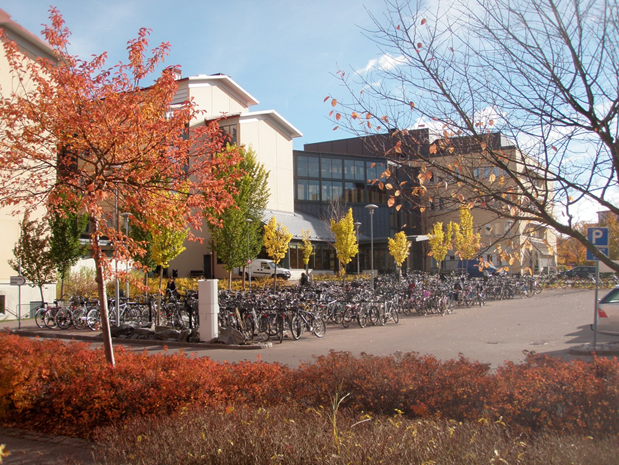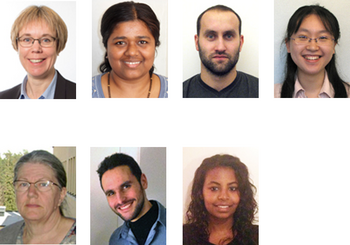Department of Immunology, Genetics and Pathology

The focus of the research project associated with GLYCANC involves the “brain tumour niche” that allows tumour cells to detach from the original site, remodel the extracellular matrix (ECM) and migrate to seed new tumours that ultimately leads to death of the patient. Based on our increased understanding of the biochemical and molecular determinants of brain tumor invasion, new drug targets in the glioma microenvironment could be identified.
Heparan sulfate (HS) proteoglycans are main components of the ECM where they interact with a large number of physiologically important macromolecules, thereby influencing biological processes. HS modulate growth factor activities, and we have shown a vital role for HS in formation of the neural lineage.
In this project we address HS proteoglycan biosynthesis and degradation in clinical brain tumour samples, human glioma cell culture as well as mouse and human models of glioma. We found that high HS fragmentation is correlated to an enhanced tumour growth, both in teratoma and brain tumours. We aim to clarify this mechanism in the enhancement of tumour growth.

Karin Forsberg Nilsson, Professor
Soumi Kundu, PostDoc
Grzegorz Wicher, PostDoc
Anqi Xiong, PhD student
Annika Hermansson, Research engineer
Argyris Spyrou, PhD student
Lulu Rahma Haseeb, PhD student
References
Xie, Y., Bergström,T., Jiang, Y., Johansson, P., Marinescu, V., Lindberg, N., Segerman, A., Wicher, G., Niklasson, M., Baskaran, S., Sreedharan, S., Everlien, I., Kastemar, M., Hermansson, A., Elfineh, L., Libard, S., Holland, E., Hesselager, G., Alafuzoff,I., Westermark, B*., Nelander, S.,*, Forsberg-Nilsson, K. * and Uhrbom,L.* (shared last authorship) The Human Glioblastoma Cell Culture Resource: Validated Cell Models Representing All Molecular Subtypes. 2015 EBioMedicine, August 2015doi:10.1016/j.ebiom.2015.08.026
Kitambi, S., Toledo, E., Usoskin, D., Wee, S., Harishankar, S., Svensson, R., Sigmundsson, K. Kalderén, C., Niklasson, M., Kundu, S., Aranda, S., Westermark, B., Uhrbom, L., Andang, M., Damberg, P., Nelander, S., Arenas, E., Artusson, P., Walfridson, J., Forsberg-Nilsson, K., Hammarström, L.G.J., Ernfors, P. Vulnerability of glioblastoma stem cells to catastrophic vacuolization and death induced by a small molecule. Cell Apr 10;157(2):313-28. 2014
Bergström, T., Holmqvist, K., Tararuk, T., Johansson, S. and Forsberg-Nilsson K. Developmentally regulated collagen/integrin interactions confer adhesive properties to early postnatal neural stem cells. BBA - General Subjects, Jan 23. pii: S0304-4165(14)00031-22014, 2014
Forsberg, M., Holmborn, K., Kundu, S., Dagälv, A., Kjéllen, L. and Forsberg-Nilsson, K. Under-sulfation of heparan sulfate restricts the differentiation potential of embryonic stem cells, The Journal of Biological Chemistry, 287, 10853-10862. 2012
Xiong, A., Kundu, S. and Forsberg-Nilsson, K. Heparan sulfates in regulation of neural differentiation and glioma development, invited review, FEBS Journal, Nov;281(22):4993-5008, 2014 Wicher, G., Holmqvist, K. and Forsberg-Nilsson, K, Common denominators of self-renewal and malignancy in neural stem cells and glioma, R. Srivastava and S. Shankar (eds.), Stem Cells and Human Diseases, chapter 17, DOI 10.1007/978-94-007-2801-1_17, © Springer Science+Business Media B.V. 2012
Kitambi, S., Toledo, E., Usoskin, D., Wee, S., Harishankar, S., Svensson, R., Sigmundsson, K. Kalderén, C., Niklasson, M., Kundu, S., Aranda, S., Westermark, B., Uhrbom, L., Andang, M., Damberg, P., Nelander, S., Arenas, E., Artusson, P., Walfridson, J., Forsberg-Nilsson, K., Hammarström, L.G.J., Ernfors, P. Vulnerability of glioblastoma stem cells to catastrophic vacuolization and death induced by a small molecule. Cell Apr 10;157(2):313-28. 2014
Bergström, T., Holmqvist, K., Tararuk, T., Johansson, S. and Forsberg-Nilsson K. Developmentally regulated collagen/integrin interactions confer adhesive properties to early postnatal neural stem cells. BBA - General Subjects, Jan 23. pii: S0304-4165(14)00031-22014, 2014
Forsberg, M., Holmborn, K., Kundu, S., Dagälv, A., Kjéllen, L. and Forsberg-Nilsson, K. Under-sulfation of heparan sulfate restricts the differentiation potential of embryonic stem cells, The Journal of Biological Chemistry, 287, 10853-10862. 2012
Xiong, A., Kundu, S. and Forsberg-Nilsson, K. Heparan sulfates in regulation of neural differentiation and glioma development, invited review, FEBS Journal, Nov;281(22):4993-5008, 2014 Wicher, G., Holmqvist, K. and Forsberg-Nilsson, K, Common denominators of self-renewal and malignancy in neural stem cells and glioma, R. Srivastava and S. Shankar (eds.), Stem Cells and Human Diseases, chapter 17, DOI 10.1007/978-94-007-2801-1_17, © Springer Science+Business Media B.V. 2012

